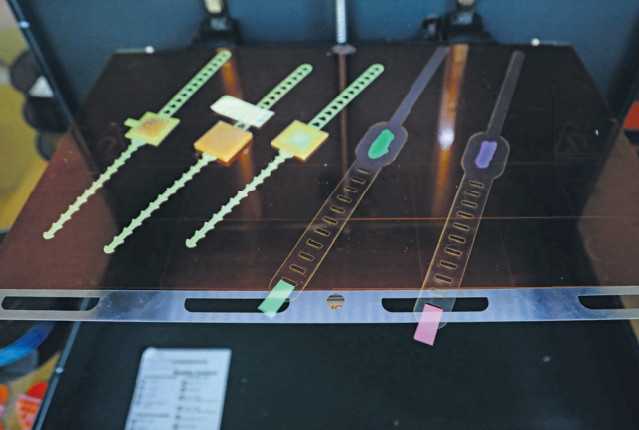
3DP Research and Innovations for Covid-19 (3DPRI-COVID19)
As part of the project by the faculty of Electrical Engineering at the University of Montenegro, titled “3DP Research and Innovations for Covid-19 (3DPRI-COVID19),” Montenegrin scientists have developed and designed a bracelet with a framework of the Montenegrin map that will change color if the person wearing it has a raised temperature, which is one of the main symptoms of Covid-19.
By the end of the year, said project manager Milena Đukanović, phd, for Dnevne novine, the second part of the research will be completed, offering a solution on how to save material during 3D printing.
“Our colleagues and partners from the Vrije University of Brussels, who are the authors of a patent for a Covid-19 mask, are very satisfied and full of praise for these discoveries. We expect valuable publications of our scientific results in the near future, as well as the commercialization of this highly useful 3D printed product, which has been branded in Montenegro,” announced Đukanović.
The “3DP research and innovations for Covid-19” project, according to Đukanović, was not randomly ranked first in the Ministry of Science’s competition for Covid-19 projects because, as she points out, it deals with an important topic and provides two highly valuable solutions for the entire world.
The project is led by the faculty of Electrical Engineering at the University of Montenegro, in collaboration with the Science and technology park of Montenegro, the Clinical Center of Montenegro, and Vrije University from Brussels.
“The main financer is the Ministry of Science with 38,500 euros, while the faculty of Electrical Engineering and the Science and technology park co-financed the project with 3,850 euros,” said Đukanović.
The project started on June 15, and, according to her, all set goals have been achieved.
“We are witnesses that all countries and their health systems are overwhelmed and exhausted by COVID-19. Also, all countries still lack the necessary medical equipment, which is why many 3D printed entities have created open-source medical parts, such as respiratory valves, all types of protective masks, face shields, but also some non-medical parts that can help reduce the spread of SARS-Cov2, such as 3D printed handrails,” said Đukanović.
In Montenegro, she says, the initiative for 3D printed aid began at the Faculty of Electrical Engineering and the Science and technology park of Montenegro.
“The Science and technology park of Montenegro has taken the role of the main coordinator for the 3D printing community, and all 3D printed components had to be verified by the Institute of Public Health of Montenegro before use. After that, as a result of these activities, a platform was created for direct cooperation with the Crisis Medical Staff and other headquarters of the National body for Coordination of Infectious Diseases,” explained Đukanović.
The main 3D printing activity in Montenegro was the production of protective masks and face shields. To date, she adds, over 17,000 protective face shields have been printed and delivered to the National Coordination Body through the coordination of the Science and technology park of Montenegro.
“During this process, it was noticed that 3D printing can be used to solve more complex problems and design new effective products, all supported by detailed research, testing, and analysis. For this reason, the Faculty of Electrical Engineering of the University of Montenegro, in coordination with the Science and technology park of Montenegro and the Clinical Center of Montenegro, decided to work together on designing a new product,” emphasized Đukanović.
The new product, she explains, consists of two parts: regular PLA filament (material for 3D printing, plastic) and temperature-dependent PLA filament that changes color depending on the temperature.
“Our tests and research aimed at designing a mask, but it was observed that the filter and breathing part affect the temperature of the filament itself. Therefore, we designed a bracelet with frames of the Montenegrin map that will change the color of the map if the person wearing it has a raised temperature,” Đukanović pointed out.
This 3D printed product, she believes, will be a true representative of Montenegrin innovations on the topic of Covid-19 and a good brand for Montenegro. In collaboration with Montenegrin companies, led by 3D room, it will also enter the commercialization phase of this product.
“We consider the product to be more practical and usable, not only for doctors but also for patients who will have information at any moment about whether they have a raised temperature, which is a common symptom of being infected with the new coronavirus,” said Đukanović.
The tests were conducted in collaboration with the director of the Science and technology park Velibor Bošković and doctors from the Clinical center of Montenegro, Eraković and Roganović, while young researchers Mavrić, Jovanović, and Radunović are intensively researching, designing, printing, and shaping results for scientific research papers, which, according to Đukanović, will be presented at the global level.
“The project will last until the end of december, and thanks to the modern equipment we received through this project, the 3D printer with two heads, thermographic camera, and 3D scanner helped us carry out all these researches in a quality manner. The second part of the research that we will finish in December is related to filament savings during 3D printing, as even during the pandemic, the situation in all countries at one point was similar and related to the material deficit for printing,” said Đukanović.
This problem was not easy to solve, as borders were closed, and there was a material deficit everywhere. Since there is no filament production in Montenegro, the only possible solution, while material was still in stock, was model optimization and subsequent thermal processing of the printed element for savings.
“In this way, new methods related to testing material strength will contribute to ensuring that everyone will be able to ‘bake’ the material for savings. Specifically, we are testing thermally untreated and treated test tubes, after which the data will be processed, and we will get graphics showing the optimal way of hardening, the percentage by which the test tube ‘strengthened,’ as well as its dimensional shrinkage. This process will result in a reduction in material consumption during 3D printing,” concluded Đukanović.
Sourse: CDM


